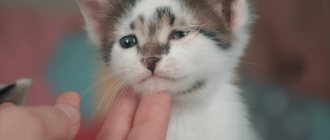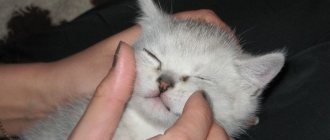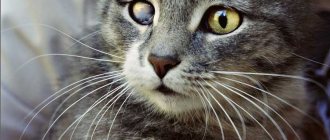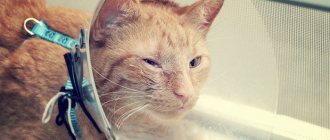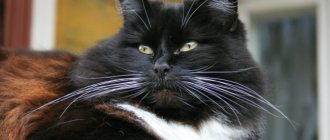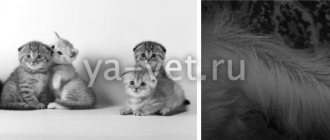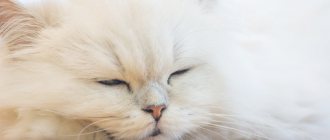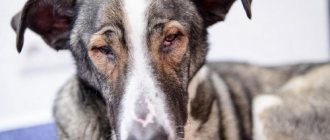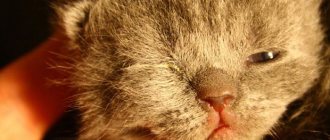A cute fluffy baby - a kitten - appeared in the house. Now the owners are responsible for his health.
Small kittens tend to be susceptible to various infections, because the animals are still weak to fight them at full strength, they can hit, get hurt, etc.
One of the consequences of these troubles may be the cause of “sour” eyes in babies. If you do not pay attention to this in a timely manner, the animal may even lose its sight!
In addition, the infection can be transmitted from a sick kitten to healthy cubs and other pets living in the house. Let's take a closer look at the causes of this condition and ways to get rid of it.
Why they fester: analysis of options and symptoms.
Viral infections
Everything is clear with this. They can be varied, and there is no point in talking about them in detail. Treatment is only prescribed by a doctor. The individuality of the kitten’s body plays a big role.
Draft
A kitten, like a person, can catch a cold in a draft. The result will be sneezing and festering eyes. In this case, it is necessary to reconsider the location of his sleeping place (house), and the treatment will be antibiotics and vitamins prescribed by a veterinarian.
Mote
A speck that gets into the eye can also cause irritation and discharge from the eye. The foreign object should be removed as soon as possible to prevent it from becoming infected.
Bruised eyelids
A severe injury of this kind is characterized by bruising, disruption of the integrity of the skin and, of course, swelling, and later - discharge from the eye. If the case is very severe, necrosis may also form.
Wounds of the eyelids
A kitten can injure its eyelid very simply: when playing with other animals or, out of curiosity, poking in the wrong place, and household chemicals, for example, get into its eye.
Blepharitis
This is the name for inflammation of the eyelid as a result of lesions of a chemical, allergic and thermal nature, as well as infection with subcutaneous parasites, seborrhea. It is not the injuries themselves that are dangerous, but the vital activity of pathogenic fungi and viruses that cause the infection. Blepharitis can also occur due to a lack of vitamins.
Purulent conjunctivitis
This disease usually appears in both eyes. The animal begins to feel unwell, and the temperature may rise. The substance released from the eyes is initially liquid, but if treatment is not started, it becomes thick, and the conjunctiva itself becomes swollen.
Follicular conjunctivitis
It occurs when the lymph nodes located in the third eyelid become inflamed. Characterized by discharge, photophobia, pain, swelling of the eyelids. Skin irritation can develop into eczema and dermatitis, and hair falls out near the affected areas.
Chlamydia
British scientists conducted studies in which it was found that in approximately one third of cats that were diagnosed with conjunctivitis, it was caused by chlamydia. Most often, kittens aged 1-9 months suffer from them, becoming infected through contact with a sick mother.
Causes of eye suppuration
You need to know why kittens' eyes fester. It can be:
- Conjunctivitis. It is considered the most common inflammatory disease of the organs of vision. Purulent discharge is caused by the active activity of bacteria. The main signs are itching and redness. In the early stages, mucous discharge is observed. Conjunctivitis in cats is easy to treat, but it should not be allowed to develop into advanced forms.
- Injuries to mucous membranes. They occur when foreign bodies enter the eyes or when scratching the eyes with claws. Minor injuries heal spontaneously. Deep wounds become entry points for infections that cause suppuration. Such injuries need to be treated.
- Blepharitis. This is the name of the inflammatory process in the mucous membranes of the eyelids. Occurs against the background of injuries and chemical burns. Accompanied by purulent discharge, swelling of soft tissues, itching and a decrease in the size of the palpebral fissure.
- Keratitis. Inflammation of the cornea occurs due to bacterial and viral infections. Keratitis is accompanied by clouding of the eyes, suppuration and pain.
- Decreased immunity. Kittens with poor health are more susceptible to inflammatory and infectious diseases.
- Poor nutrition. Feeding low-quality feed causes metabolic disorders that can provoke eye diseases.
- Living in dusty rooms. Dust and debris fall on the surface of the eyeball, causing irritation.
- Drafts and hypothermia. Against the background of a cold, kittens often develop purulent discharge from the conjunctival sac.
- Chlamydia. Chlamydial infections in kittens are in most cases congenital. The disease begins with inflammation of the cornea and eyelids. Later, lacrimation and suppuration appear.
- Allergic reactions. Occur after contact with detergents and medications. An allergic reaction causes swelling and watery eyes. The animal's eyes are itchy and watery.
- Atopic dermatitis. The disease is seasonal and allergic in origin. Exacerbations occur during the flowering period.
- Genetic predisposition. Kittens born from cats suffering from eye diseases in most cases have the same problems.
- Congenital defects. Suppuration can be caused by incorrect location of the hair follicles, deformation of the lacrimal canal, absence of the lacrimal punctum, inversion of the lower eyelid, eyelashes growing in 2 rows. At first, the kitten's eyes water. Later, an infection develops, causing purulent discharge. Congenital defects are corrected surgically.
How to treat?
What to do? The process of therapy. Treatment
The cat baby will need help immediately, and you should start by treating the affected areas. To do this, prepare a chamomile decoction or calendula decoction, a strong solution of tea or furacelin, and then wash the kitten’s eyes by soaking a cotton pad or a piece of cotton wool in the liquid.
You can also prepare a saline solution (dilute a teaspoon of salt in a liter of boiled water), but it is not suitable for allergic reactions.
Important!
Under no circumstances should you use alcohol solutions, even very weak ones, to treat your eyes! This will only make things worse.
How to drip correctly?
The baby is held tightly in your arms, but the body is not squeezed (you can wrap it in a rag). The medicine is dripped into the treated eyes, carefully spreading the eyelids apart. It should get into the eye and wash it well and roll down to the kitten’s nose.
Recommended drugs
Rinsing the eyes does not always help, and in any case it is better to visit a veterinarian. If we name ointments and drops that are usually prescribed to kittens for diseases of the eyelids of various types, then these include tetracycline ointment, the drugs “Iris”, “Leopard”, “Levomycetin”, “Gentamicin”, “Diamond Eyes”, “Lakrikan”, “ Anandin", "Ciprotsvet", and others.
Advice:
Before use, be sure to carefully read the instructions for use of the medicine. If the pain is very strong, then antibiotics with novocaine are injected into the conjunctival sac.
What you can do yourself at home
If the kitten's eye(s) are not severely damaged, the owners can easily rid it of this problem on their own, that is, wash it several times a day. For more severe damage, instill drops or apply ointment (medication must be prescribed by a doctor).
Blepharitis - inflammation of the eyelid
The first signs of blepharitis disease are redness and thickening of the conjunctiva. Inflammation may be accompanied by the release of pus, mucus, the appearance of bleeding ulcers, and severe lacrimation. If left untreated, the inflammatory process spreads to nearby organs.
The causes of blepharitis are different:
- mechanical eye injury or burn (thermal or chemical);
- manifestation of allergies to medications or food;
- fungal or bacterial infection;
- parasite infection.
To treat blepharitis, even at the initial stage, it is not enough to relieve the inflammatory process, since it is necessary to determine the initial cause of the disease, and this can only be done by a qualified specialist.
Blepharitis is often confused with conjunctivitis, but they are different diseases and require different treatments.
Other Features
Why do eyes fester with a runny nose?
Exudation from the eyes of a kitten in parallel with a runny nose is a serious reason to be wary and immediately consult a doctor. This may be the beginning of the development of viral rhinotracheitis, bronchial asthma or calicivirus - diseases that are very dangerous for a fragile body. Allergies cannot be ruled out either.
Tears
When a kitten's eyes are slightly watery, this indicates the natural process of cleansing them or that dust (dirt) has entered them, and in this case you should not panic, but simply wash them for a while. Don’t be scared in the same way if your baby behaves restlessly and meows - he shows dissatisfaction, this is a completely adequate reaction.
Reference!
Tearfulness is also characteristic of some breeds of cats: British, Sphynx, Rex, Persian. All other cases are the beginning of serious illnesses.
Why don’t my eyes open and swell and what should I do?
Swelling of the eyelids is common in almost any disease or injury. To determine the type of infection that has affected the eye, special diagnostics are necessary.
Reference!
There are some other factors that temporarily weaken the body and can contribute to the development of infections - these are deworming and vaccination. It is worth keeping in mind that a small kitten should not be given economy-class food, as this also increases the risk of developing eye infections.
Red eyes
The redness of an animal's eyes will also indicate the presence of some fairly serious diseases that require long-term treatment or even surgical intervention (uveitis, keratitis, lens luxation, etc.). Causes also include allergic reactions and injuries, dry eye syndrome.
Diagnosis of pathologies
If a kitten's eyes are festering, they will be examined by a veterinarian. Diagnosis of the disease includes:
- Visual inspection. The doctor identifies the first signs of the disease - swelling of the eyelids, redness of the sclera, reduction in the size of the palpebral fissure.
- Examination using an ophthalmoscope. The device, equipped with a light and a magnifying glass, helps to identify small wounds and ulcers of the cornea.
- Bacteriological examination of discharge from the conjunctiva. Helps determine why a kitten's eyes become sour and assess the sensitivity of the infectious agent to antibacterial substances.
Prevention
The health of a pet depends on many factors, and above all, on the attentiveness of the owners. Preventive measures are also important. It’s not difficult to follow them, and the result will be, as they say, “on the face.”
- If, due to his age, the kitten is not yet able to wash himself thoroughly, he needs help - washing his eyes daily with the above-mentioned chamomile decoction, strong tea, etc.
- If an animal has an injury to the area near its eye, it must be disinfected and the fur nearby must be cut off. It may be worth considering trimming the nails to prevent the animal from injuring itself.
- In order for the animal to have a strong immune system (which also affects the condition of the eyes), it is important to feed it properly.
- If there are several pets living in the house, wash their eyes, just like a sick kitten - as a preventive measure.
Glaucoma - an increase in the size of the eyeball
In glaucoma, deformation in the tissues of the eye occurs due to increased intraocular pressure. This differs from dropsy, in which the eyeball enlarges as a result of an infectious process.
Symptoms of glaucoma:
- enlarged pupil (mydriasis);
- increased amount of discharge from the eyes;
- bending of the cornea and its clouding;
- redness and swelling of the eyelids;
- photophobia.
Mydriasis is one of the first signs of glaucoma
There are quite a few reasons that contribute to glaucoma:
- congenital defects in the structure of the drainage structure of the eye;
- eye diseases that have become chronic: conjunctivitis, uveitis (a general name for inflammatory processes of various eye tissues), tumors;
- mechanical damage to the organs of vision or head;
- diabetes;
- obesity;
- increased blood pressure;
- use of hormonal drugs;
- aging.
The disease has a genetic predisposition. The offspring of cats suffering from glaucoma develop this disease several times more often.
Some breeds of domestic cats get sick more often, these include:
- Siamese;
- Persian;
- Burmese;
- European shorthair.
Outbred pets are the most resistant to the disease.
If you suspect glaucoma, you should immediately contact a veterinary clinic. The disease is well diagnosed by modern methods of ophthalmological examination, including measuring intraocular pressure (IOP).
The use of medications is aimed at stabilizing IOP and relieving deformations that have occurred in the eye tissues. There is a practice of effective laser treatment, but this method is very expensive and not all clinics have the appropriate equipment. Possible surgical treatment methods include the creation of a tubular drainage to ensure the outflow of intraocular fluid.
In extreme cases, if there is no possibility of restoring vision, the eyeball is removed.
Obstruction of the lacrimal ducts
One of the causes of excessive lacrimation in a cat is stenosis - obstruction of the nasolacrimal duct.
The causes of this pathology may be different;
- a foreign body that has entered the canal and clogged it;
- conjunctivitis or other inflammatory processes in which the released pus can close the nasolacrimal duct;
- tear duct injuries;
- congenital insufficiency of the width of the mouth or neck of the lacrimal ducts.
Some cat breeds are predisposed to developing this disease, including:
- Scottish and British cats;
- exotics;
- Persians.
Obstruction of the nasolacrimal duct is determined using a special test. Before starting the procedure, the animal's eyes are thoroughly washed with an antibiotic solution to completely remove pus and other secretions. 1-2 drops of an organic dye solution (fluorescein) are instilled into the eye. During normal operation of the channels, after two minutes the internal cavity of the pet’s nose and mouth will acquire a greenish color. If this effect is obtained after ten minutes, then a partial blockage is diagnosed. Complete absence of staining indicates stenosis.
The course of treatment depends on the cause of the disease. First, the inflammatory process is relieved. If after this the functioning of the tear ducts is not restored, bougienage is performed - prompt removal of the plug blocking the duct.
